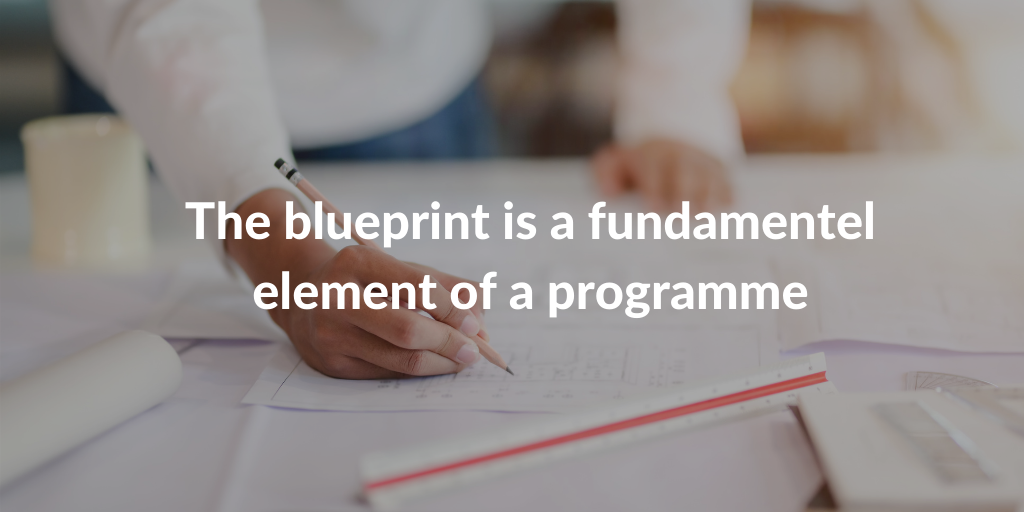Blueprint: its definition and importance for a successful programme

The blueprint is a fundamental element of a program.
The subject of the blueprint is one of the key elements of program management and in particular of Axelos MSP (Managing Successful Programs) best practice.
A blueprint captures the skills an organisation wants to own at the end of the programme.
It helps decide which systems and what technology the organisation requires to succeed.
It helps elaborate on the needed skills and abilities and what kind of culture the organisation wants to create.
While vision within a programme is key to keep work relevant and aligned, it is also true that an organisation needs a more detailed model that describes what the desired future state is and how this will work.
This is the objective of the blueprint.
In practice, the blueprint provides the “behind the scenes” details of the vision.
It does so by describing how to get from A (where we are now) to B (where we want to be).
An organisation cannot move from an existing operating model to a future one overnight.
Especially considering the level of change and investment required. Instead, the changes must be gradual and develop over a period of 3 to 5 years. All these factors make that the blueprint is based on two pillars:
- What do we need?
What are the skills we need in the future organisation? - What will the change process be like?
What is the time investment?
The blueprint directs organisations towards strategic long-term investments, as opposed to business as usual and the annual budget that drives the short term and technology solutions.
An example of a blueprint
An organisation wants to expand its range of services over a period of 5 years: the blueprint serves to clarify which services to improve, which services to continue to offer unchanged and which to start and stop. Once the organisation clearly knows the desired service offer, it can understand what is needed to provide these services.
The blueprint helps to capture the capacity gap between the current state and the future state.
By definition, the blueprint exists
“to keep the focus on delivering the required transformation and business change”. *
How to create a programme blueprint
Organisations often do not invest enough in preparing a programme and underestimate the time and detail needed to outline the vision and design the blueprint. Sometimes it happens that the “delivery mode” is activated without having a coherent view of the total capacity required.
If you are not careful enough, this can turn into a misaligned and inefficient business model.
The work that goes into blueprinting is critical to establish the foundations of a coherent future business model that considers processes, the organisation, technology and information as a compelling and comprehensive solution.
One of the most important aspects of the blueprint is that it must be aligned with the future vision.
Some organisations are skeptical of making it visible, but according to Martin Stretton
“all resources need to feel involved in the change process, not just senior management”. **
In order to increase participation the question to ask is ‘how can we bring the team with us on this path‘?
When defining roles and competencies, you may need roles other than existing ones.
At this point, external people can be hired or the own team can be taught new capacities and skills.
The blueprint provides the framework to inform resources about these decisions and move forward.
The blueprint gives substance to the vision and includes details of the current state of the programme (where we are now) and how the future operating model will work (where you want to be). It elaborates on the differences between the two – in order to provide insight and so you can cover them with projects and other programme activities.
The blueprint may contain details of the future organisational structure, processes, functions and performance levels and what technologies and information can be used to support them.
In practice, the blueprint shows the skills/ competences the programme aims to achieve.
4 tips to write a Blueprint
Some things to keep in mind when designing a blueprint are:
Involve the right resources
Involve resources who know the business and who can help define the future state of the organisation.
For example business change managers.
Start an iterative process
You will be able to develop the first draft of the blueprint based on the initial vision and the benefits you want to achieve. However, this initial vision will change once you will review the benefits and see more clearly the costs and timing required to achieve them.
The blueprint could therefore change. As you develop your blueprint, you may realize that the work required is too expensive, takes too much time, or does not lead to the benefits your organisation needs.
So you may have to go back and rethink the blueprints needed to achieve the desired future state, or go back and review the blueprint content.
Review the overall business case
In the iterative process of creating the blueprint, at some point the programme should demonstrate an acceptable balance of cost, benefit, time and risk. Once the equilibrium is reached, you can check the business case to validate its feasibility and convenience. After that you can formally approve the business case.
Use the blueprint throughout the programme
During the programme, make sure you are in the right direction.
The blueprint provides the basis for developing project requirements and should be used to check that project outputs will help develop the required business capabilities.
Finalized blueprint
When you have completed your blueprint and achieved the expected final results, you can close the programme.
As part of the closure you can review what was delivered and make sure you have the correct KPIs to continue tracking benefits realization after the programme closes.
MSP Best Practice highlights the importance of the blueprint and how to use it, along with other elements such as the business case and programme plan, to design and implement a successful programme.
Sources: *Axelos, Managing Successful Programmes: setting the blueprint for a better future
**Axelos, A blueprint for change
Axelos, The blueprint – a cornerstone of programmes and MSP








